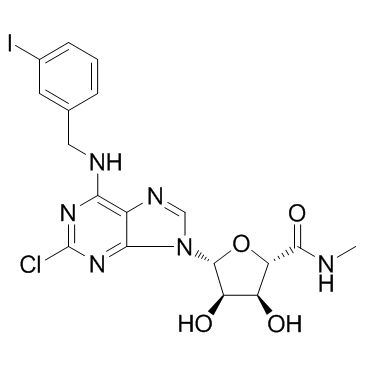Adenosine A3 receptor agonists protect HL-60 and U-937 cells from apoptosis induced by A3 antagonists.
Y Yao, Y Sei, M P Abbracchio, J L Jiang, Y C Kim, K A Jacobson
Index: Biochem. Biophys. Res. Commun. 232 , 317, (1997)
Full Text: HTML
Abstract
The effects of novel, selective adenosine (ADO) A3 receptor antagonists of diverse structure on cells of the human HL-60 leukemia and U-937 lymphoma cell lines were examined. Both 3-ethyl 5-benzyl 2-methyl-6-phenyl-4-phenylethynyl-1,4-(+/-)-dihydropyridine-3, 5-dicarboxylate (MRS 1191, 0.5 microM) and 6-carboxy-methyl-5, 9-dihydro-9-methyl-2-phenyl-[1,2,4]-triazolo [5,1-a][2,7]naphthyridine (L-249313, 0.5 microM) induced apoptotic cell death and expression of bak protein. Low concentrations of the A3 receptor agonist 2-chloro-N6-(3-iodobenzyl)adenosine-5'-N-methyluronamide (Cl-IB-MECA, 10 nM or 1 microM) protected against antagonist-induced cell death. At concentrations > or = 10 microM, the agonist alone produced apoptosis and bak expression in various cell lines. It is suggested that there exists a tonic low level of A3 receptor activation, possibly induced by release of endogenous adenosine, that results in cell protection.
Related Compounds
| Structure | Name/CAS No. | Molecular Formula | Articles |
|---|---|---|---|
 |
2-CL-IB-MECA
CAS:163042-96-4 |
C18H18ClIN6O4 |
|
The combination of Cl-IB-MECA with paclitaxel: a new anti-me...
2014-10-01 [Cancer Chemother. Pharmacol. 74(4) , 847-60, (2014)] |
|
Activation of hippocampal adenosine A3 receptors produces a ...
1997-01-15 [J. Neurosci. 17 , 607-614, (1997)] |
|
Modulation of A1 and A2B adenosine receptor activity: a new ...
2014-01-01 [Cell Death Dis. 5 , e1539, (2014)] |
|
A novel cardioprotective function of adenosine A1 and A3 rec...
1997-07-01 [Am. J. Physiol. 273 , H501-H505, (1997)] |